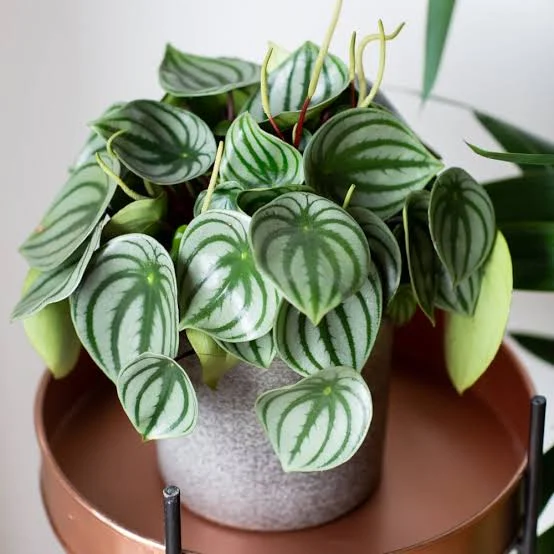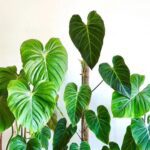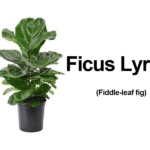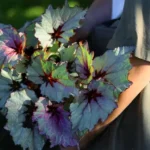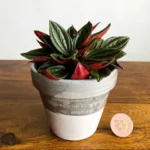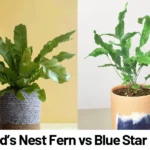Getting to Know the Watermelon Peperomia
Peperomia argyreia, affectionately known as the Watermelon Peperomia, is a striking tropical plant cherished for its unique foliage. Its name comes from the vivid, watermelon-rind pattern that covers its round, succulent-like leaves. Native to the tropical rainforests of South America, particularly Brazil, this plant thrives in warm, humid environments and makes for a perfect addition to an indoor jungle. Whether you’re a seasoned plant parent or just beginning your indoor plant journey, Peperomia argyreia is a low-maintenance favorite that adds a bold touch of greenery to any space.
Appearance and Growth Habits
The Watermelon Peperomia is a relatively compact plant, typically reaching 8–12 inches in height and width. It grows in a mounding or slightly spreading habit, making it ideal for small shelves, tabletops, or windowsills. The defining feature is its thick, oval-shaped leaves with vibrant silver stripes radiating from a dark green midrib, creating the visual illusion of a watermelon rind. The red to pinkish stems contrast beautifully with the foliage, making this plant even more visually appealing.
Watermelon Peperomia Growth Characteristics
- Size: Up to 12 inches tall and wide
- Leaves: Broad, disk-like, and slightly cupped
- Stems: Reddish and succulent
- Flowers: Small, spike-like, and usually appear in summer; not particularly decorative
Light Requirements
Light is one of the most critical care components for Peperomia argyreia. In its native habitat, it thrives under the filtered canopy of tall rainforest trees, so replicating similar indirect lighting indoors is key.
Best Lighting Conditions
- Bright, indirect light: Near north or east-facing windows is ideal. Direct sunlight can scorch the leaves.
- Low light tolerant: Can survive in lower light environments, although growth may slow, and leaf variegation may fade.
- Avoid strong midday sun: Use sheer curtains or place the plant a few feet from a bright window to prevent leaf burn.
Watering and Humidity
Peperomia argyreia prefers slightly moist soil but dislikes sitting in water. Overwatering is one of the most common mistakes made by beginners and can lead to root rot.
Watering Guidelines
- Allow the top 1–2 inches of soil to dry out before watering again.
- Use a watering method that provides deep, even moisture without waterlogging the soil.
- Empty the saucer under the pot after watering to prevent stagnation.
Humidity Preferences
As a tropical plant, it appreciates higher humidity levels, especially in dry, heated indoor environments. While Peperomia argyreia can adapt to average home conditions, it will really thrive with a bit of extra moisture in the air.
- Use a humidity tray or small humidifier, especially in winter.
- Group with other houseplants to create a micro-humidity environment.
- Avoid placing near radiators or air vents that cause dry air.
Soil and Repotting
This plant enjoys a well-draining potting mix that retains some moisture but doesn’t stay soggy. A blend designed for indoor foliage or tropical plants will generally work well.
Soil Tips
- Use a mix of peat moss, perlite, and regular potting mix in equal parts.
- Ensure that the pot has drainage holes to avoid waterlogging.
Repotting Advice
- Repot every 2–3 years or when roots become crowded.
- Choose a new pot only slightly larger than the current one to prevent prolonged wet soil.
- Spring is the best time to repot for minimal stress.
Temperature and Fertilizer for Watermelon Peperomia
Peperomia argyreia prefers a consistent temperature environment that mimics its native habitat. Extremes in temperature, especially drafts or sudden cold snaps, should be avoided.
Ideal Temperature Range
- 65°F to 80°F (18°C to 27°C) is optimal.
- Don’t allow temperatures to fall below 50°F (10°C).
- Avoid placing the plant near drafty windows or in direct path of air conditioning.
Feeding Guidelines
- Fertilize during the growing season (spring through early fall).
- Use a balanced, diluted houseplant fertilizer every 4–6 weeks.
- Do not over-fertilize; too much can damage roots and affect leaf color.
Propagation Tips for Watermelon Peperomia
One of the joys of owning a Peperomia argyreia is how simple it is to propagate. This makes it a great option for beginner gardeners looking to expand their plant collection or share plants with friends.
Stem Cutting Method
- Use sterilized scissors to snip a healthy stem with at least one leaf attached.
- Place the cutting in water or damp soil until roots develop (usually a few weeks).
- Once rooted, transplant into a small pot with well-draining soil.
Leaf Cutting Method
- Cut a healthy leaf into two halves (including part of the stem base).
- Bury each segment slightly in damp soil with the cut side down.
- Keep in a warm, humid location and wait patiently for new shoots.
Common Problems and Solutions
Peperomia argyreia is considered easygoing, but like all plants, it can occasionally run into issues. Understanding the signs of stress early can help prevent bigger problems.
Yellowing Leaves
- Often a sign of overwatering or poor drainage.
- Check potting mix and cut back watering frequency.
Brown Leaf Edges
- Usually caused by low humidity or prolonged dryness.
- Increase humidity or ensure soil isn’t remaining too dry between waterings.
Drooping Stems
- Could indicate underwatering, overwatering, or root issues.
- Inspect soil moisture and root health to determine cause.
Pest Trouble
Though relatively pest-resistant, it can occasionally attract pests like fungus gnats, spider mites, or mealybugs — especially if overwatered.
- Keep an eye out for sticky residues, webbing, or cotton-like substances.
- Treat with neem oil or insecticidal soap at the first sign of infestation.
Why Choose Peperomia argyreia?
This plant is perfect for people who want a splash of color and texture in their indoor spaces without a complicated care routine. It performs well in small spaces, adapts to many indoor conditions, and is non-toxic to pets, making it a safe and stylish choice for families and pet owners alike.
- Pet safe: Nontoxic to cats and dogs
- Compact: Perfect for apartments and indoor shelves
- Stylish: Decorative foliage stands out in any plant collection
Final Thoughts
Peperomia argyreia is a treasured addition to any indoor plant setup. It’s beautiful, compact, and easy to care for with just a little attention to lighting, watering, and humidity. Whether you’re just beginning your plant journey or looking to expand your collection with unique foliage, this watermelon-patterned wonder is a foolproof pick. Give it the right environment, and it will reward you with vibrant leaves and a cheerful presence all year long.
References
- Growell, P. (2020). Peperomias: A Living Garden Indoors. Houseplant Press.
- Steinkopf, L. (2019). Houseplant Party: Fun Projects and Growing Tips for Epic Indoor Plants. Cool Springs Press.
- Royal Horticultural Society. (2023). Peperomia argyreia (Watermelon Peperomia). Retrieved from https://www.rhs.org.uk

